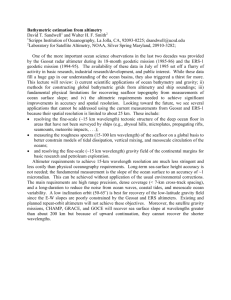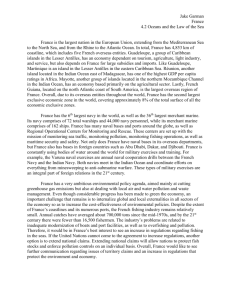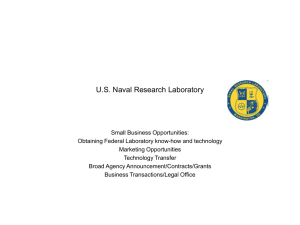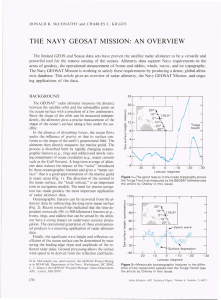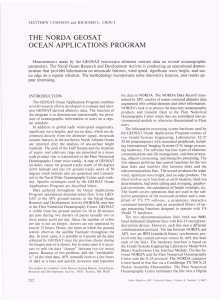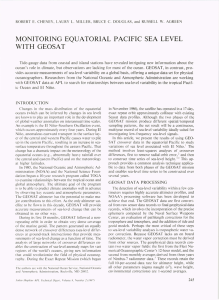THE NAVY GEOSAT MISSION: AN ... - -_ _ _ _ _ _ _ _ _... THEME ARTICLES fohns Hopkins APL Technical Di-
advertisement
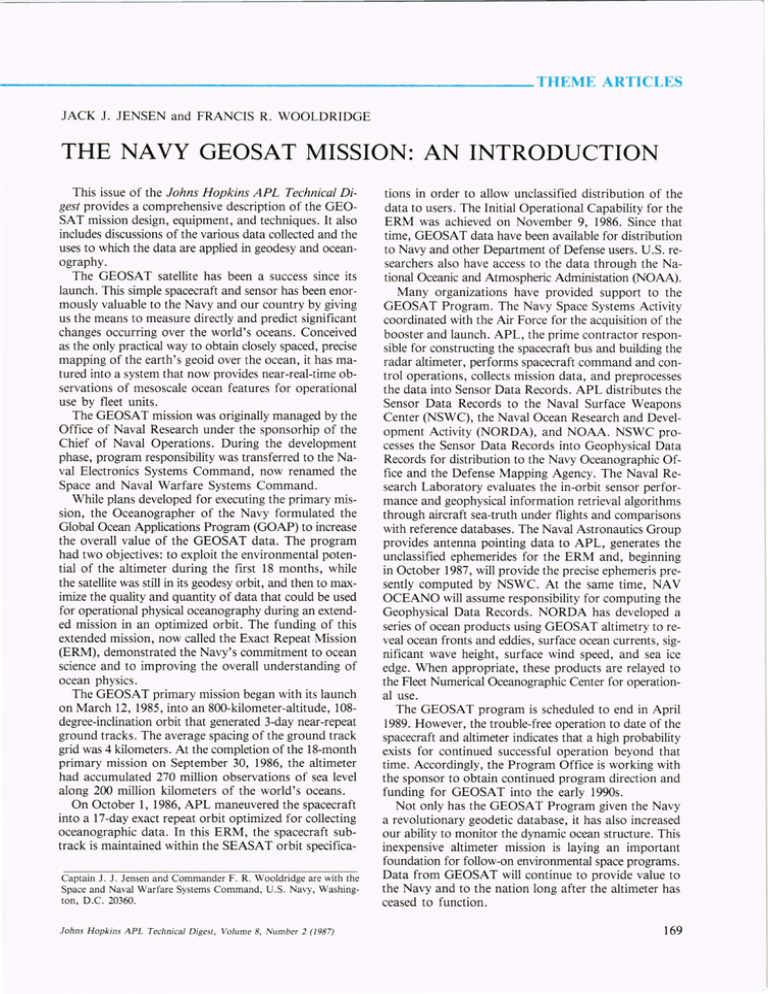
- -_ _ _ _ _ _ _ _ _ _ _ _ _ _ _ _ _ _ _ _ _ _ _ _ THEME ARTICLES JACK J. JENSEN and FRANCIS R. WOOLDRIDGE THE NAVY GEOSAT MISSION: AN INTRODUCTION This issue of the fohns Hopkins APL Technical Digest provides a comprehensive description of the GEOSAT mission design, equipment, and techniques. It also includes discussions of the various data collected and the uses to which the data are applied in geodesy and oceanography. The GEOSAT satellite has been a success since its launch. This simple spacecraft and sensor has been enormously valuable to the Navy and our country by giving us the means to measure directly and predict significant changes occurring over the world's oceans. Conceived as the only practical way to obtain closely spaced, precise mapping of the earth's geoid over the ocean, it has matured into a system that now provides near-real-time observations of mesoscale ocean features for operational use by fleet units. The GEOSAT mission was originally managed by the Office of Naval Research under the sponsorhip of the Chief of Naval Operations. During the development phase, program responsibility was transferred to the Naval Electronics Systems Command, now renamed the Space and Naval Warfare Systems Command. While plans developed for executing the primary mission, the Oceanographer of the Navy formulated the Global Ocean Applications Program (GOAP) to increase the overall value of the GEOSAT data. The program had two objectives: to exploit the environmental potential of the altimeter during the first 18 months, while the satellite was still in its geodesy orbit, and then to maximize the quality and quantity of data that could be used for operational physical oceanography during an extended mission in an optimized orbit. The funding of this extended mission, now called the Exact Repeat Mission (ERM) , demonstrated the Navy's commitment to ocean science and to improving the overall understanding of ocean physics. The GEOSAT primary mission began with its launch on March 12, 1985, into an 800-kilometer-altitude, 108degree-inclination orbit that generated 3-day near-repeat ground tracks. The average spacing of the ground track grid was 4 kilometers. At the completion of the 18-month primary mission on September 30, 1986, the altimeter had accumulated 270 million observations of sea level along 200 million kilometers of the world's oceans. On October 1, 1986, APL maneuvered the spacecraft into a 17-day exact repeat orbit optimized for collecting oceanographic data. In this ERM, the spacecraft subtrack is maintained within the SEASAT orbit specificaCaptain J . J. Jensen and Commander F . R. Wooldridge are with the Space and Naval Warfare Systems Command, U. S. Navy, Washington , D.C. 20360. John s Hopkin s APL Technical Digest, Volume 8, N umber 2 (1987) tions in order to allow unclassified distribution of the data to users. The Initial Operational Capability for the ERM was achieved on November 9, 1986. Since that time, GEOSA T data have been available for distribution to Navy and other Department of Defense users. U.S. researchers also have access to the data through the National Oceanic and Atmospheric Administation (NOAA). Many organizations have provided support to the GEOSAT Program. The Navy Space Systems Activity coordinated with the Air Force for the acquisition of the booster and launch. APL, the prime contractor responsible for constructing the spacecraft bus and building the radar altimeter, performs spacecraft command and control operations, collects mission data, and preprocesses the data into Sensor Data Records. APL distributes the Sensor Data Records to the Naval Surface Weapons Center (NSWC), the Naval Ocean Research and Development Activity (NORDA), and NOAA. NSWC processes the Sensor Data Records into Geophysical Data Records for distribution to the Navy Oceanographic Office and the Defense Mapping Agency. The Naval Research Laboratory evaluates the in-orbit sensor performance and geophysical information retrieval algorithms through aircraft sea-truth under flights and comparisons with reference databases. The Naval Astronautics Group provides antenna pointing data to APL, generates the unclassified ephemerides for the ERM and, beginning in October 1987, will provide the precise ephemeris presently computed by NSWC. At the same time, NAV OCEANO will assume responsibility for computing the Geophysical Data Records. NORDA has developed a series of ocean products using GEOSAT altimetry to reveal ocean fronts and eddies, surface ocean currents, significant wave height, surface wind speed, and sea ice edge. When appropriate, these products are relayed to the Fleet Numerical Oceanographic Center for operational use. The GEOSAT program is scheduled to end in April 1989. However, the trouble-free operation to date of the spacecraft and altimeter indicates that a high probability exists for continued successful operation beyond that time. Accordingly, the Program Office is working with the sponsor to obtain continued program direction and funding for GEOSAT into the early 1990s. Not only has the GEOSAT Program given the Navy a revolutionary geodetic database, it has also increased our ability to monitor the dynamic ocean structure. This inexpensive altimeter mission is laying an important foundation for follow-on environmental space programs. Data from GEOSAT will continue to provide value to the Navy and to the nation long after the altimeter has ceased to function. 169

